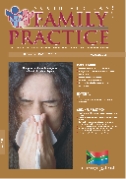Self-Reported Adverse Effects as Barriers to Adherence to Antiretroviral Therapy in HIV-Infected Patients in Pretoria
Keywords:
adherence, adverse effects, side effects, antiretroviral treatment
Abstract
Background: Adherence is the key to the effectiveness of antiretroviral therapy. However, many factors have been identified as facilitating or hampering adherence. The aim of this study was to determine barriers and facilitators of adherence with particular emphasis on adverse effects. Methods: A survey of patients, who started antiretroviral treatment between July 2004 and August 2005, was conducted by means of a semi-structured questionnaire. Those who consented to participate were interviewed for the collection of information on sociodemographic characteristics and clinical and other data. Results: The 180 patients who participated had a mean age of 36.7 (±8.1); 68.8% were female, 86.7% unemployed, 73.9% had a high school level of education, and 77.8% were single. Some 8.9% of the respondents used at least one non-prescribed medicine, while 34.4% received disability grants. Overall, 94% of the respondents reported at least one side effect; the mean number of self-reported side effects was 2.6 (± 1.4). With regard to adherence, the mean number of doses missed during the last seven days prior to the interview was 2.7 (±3.9), ranging from 0 to 18. The mean adherence level was 92.3%, ranging from 48.6% to 100.0%; overall, only 57.2% reported taking at least or over 95% of their prescribed doses. The two most common reasons for missing doses were forgetting (26.6%) followed by being away from home (15.6%). In the bivariate analysis, the only facilitator or factor that was significantly associated with at least or over 95% self-reported adherence was eating well (80.6% vs 64.5%; p = 0.025), whereas barriers or factors more likely and significantly associated with with self-reported adherence of at least or over 95% included having used non-prescribed medicines (15.6% vs 3.9%; p = 0.008), having suffered from headaches (28.6 vs 14.6%; p = 0.026) and reported symptoms such as insomnia (27.3% vs 12.6%; p = 0.013) and abdominal pain (20.8% vs 9.7%; p = 0.037). In the multivariate analysis, the facilitators or factors that were significantly associated with self-reported adherence of at least or over 95% were having an initial bodyweight of less than 50 kg (p = 0.026) and viral load of >33 000 copies /ml (p = 0.047). Conclusions: In conclusion, self-reported barriers to optimal adherence included the use of non-prescribed drugs, and the presence of side effects such as insomnia, headaches and abdominal pain; while eating well was a facilitator. These findings emphasise the need for better communication between patients and clinicians, and the need for integrating pharmacovigilance concepts in clinical practice.
Published
2008-07-04
Section
Original Research
By submitting manuscripts to SAFP, authors of original articles are assigning copyright to the South African Academy of Family Physicians. Copyright of review articles are assigned to the Publisher, Medpharm Publications (Pty) Ltd, unless otherwise specified. Authors may use their own work after publication without written permission, provided they acknowledge the original source. Individuals and academic institutions may freely copy and distribute articles published in SAFP for educational and research purposes without obtaining permission.

